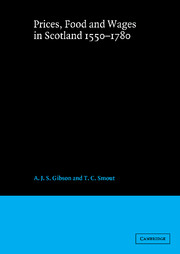Book contents
- Front Matter
- Contents
- Figures
- Tables
- Acknowledgements
- Abbreviations
- A note on Scottish and English money
- Map of Scottish counties and principal burghs
- 1 Introduction
- 2 The system of burgh price regulation
- 3 The system of county fiars
- 4 Press reports of monthly market prices
- 5 Trends and fluctuations in grain-price movements
- 6 The price of animals and animal products
- 7 Food
- 8 Wages in money and kind
- 9 Real wages
- Appendix I Scottish weights and measures, 1580–1780
- Appendix II Accessing the data
- Bibliography
- Persons index
- Place index
- Subject index
5 - Trends and fluctuations in grain-price movements
Published online by Cambridge University Press: 22 September 2009
- Front Matter
- Contents
- Figures
- Tables
- Acknowledgements
- Abbreviations
- A note on Scottish and English money
- Map of Scottish counties and principal burghs
- 1 Introduction
- 2 The system of burgh price regulation
- 3 The system of county fiars
- 4 Press reports of monthly market prices
- 5 Trends and fluctuations in grain-price movements
- 6 The price of animals and animal products
- 7 Food
- 8 Wages in money and kind
- 9 Real wages
- Appendix I Scottish weights and measures, 1580–1780
- Appendix II Accessing the data
- Bibliography
- Persons index
- Place index
- Subject index
Summary
Long-term trends to ca.1650
In the three preceding chapters we have laid out and explained a series of price tables for grains and grain-based foods, drawn from burghal records, from fiars and from monthly press reports. The purpose of this chapter is to attempt a broad description and interpretation of both long-term and short-term trends, to give our figures a context.
First, however, it is worth explaining again that throughout the foregoing tables and in the course of this chapter, our use of dates refers to ‘crop years’. Thus when we state, for example, that ‘1622 was a dear year’, what we are saying is that prices were high following the crop of 1622, which begins to be cut in the early autumn of 1622 and is the basis of burgh assessments set around November 1622 and of the fiars struck in or around February 1623. In either case the price structure determined by that harvest ruled until supply conditions were altered by expectations concerning the following harvest in the late summer or autumn of 1623. This needs to be borne in mind by, for example, demographic historians trying to correlate prices with mortality in the spring of the calendar year 1623 or social historians interested in vagrancy in the summer of the same calendar year. In each case the relevant price statistic is headed in our tables 1622, not 1623.
- Type
- Chapter
- Information
- Prices, Food and Wages in Scotland, 1550–1780 , pp. 162 - 184Publisher: Cambridge University PressPrint publication year: 1994



